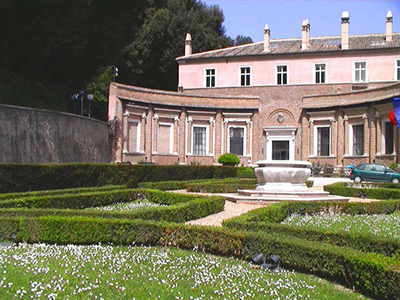Villa Madama is a famous rural villa built during the Italian Renaissance.
Even though it is incomplete, the villa together with its loggia plus segmented columned garden court as well as its casino with the terraced gardens and an open centre, was very influential for subsequent High Renaissance architects. The reigning pontiff (Leo X) cousin, Cardinal Giulio de' Medici commissioned the original design of Villa Madama from Raphael. In 1520, Raphael died when he was 37 years old; at this time, work at this villa was far from being completed. The construction began in the year 1518 and was passed on to Raphael's disciples, who were one of the most ingenious teams ever constructed a site.
However, without Raphael present to smooth over disagreements, they always quarrelled. Antonio da San Gallo produced the final plans of the Villa; he supervised the actual construction as well. The person responsible for which design still remains unclear. The decorations are by Baldassare Peruzzi and Giulio Romano. Giovanni da Udine finished the stucco bas-reliefs, which was imitating work that was found in Nero's Domus Aurea, which was recently rediscovered. Finally, both Baccio Bandinelli from Florence and Giovan Francesco ("il Fattore") also worked there.
Apart from the Raphael loggia, this villa's greatest artistic component is the Giulio Romano's salone, with its beautiful vaulted ceiling. After Alessandro de' Medici's illegitimate son (Giulio Alessandro de' Medici) became the 2nd Medici pope, as Pope Clement VII in the year 1523, work continued in 1524 to 1525 but stopped again in the year 1527 during the military event called the Sack of Rome.The villa suffered damage during this time. While parts of the villa were rebuilt, it was never completed.
The villa is owned by the Italian Government; it uses Villa Madama for press conferences and international guests. Entrance is restricted and touring of gardens needs prior permission from the Ministry of Foreign Affairs. The Italian European Union Presidency hosted a dinner here for all Presidents and Speakers of European Union national parliaments on 20 April 2015. Margaret of Austria was a Madama of its name. After Clement VII death, the villa remained the property of Medici, which first belonged to Ippolito de' Medici (Giuliano di Lorenzo de' Medici's son), and later to the Lord of Florence (Duke Alessandro), who married Archduchess Margaret of Austria, but was left a widow when she was 15 years old. She married Pope Paul III nephew, Ottavio Farnese, and was widowed again. After the death of Margaret, the villa passed on to the Farnese family Piacenza and Piacenza, who gradually let it fall into ruin.
This villa was among the first of the restored Roman suburban type villas designed for entertainment and parties built in the sixteenth century Rome. It was consciously considered to rival the villas descriptions of Antiquity, such as Pliny's popular description of his own. The villa had a courtyard with an open-air theatre that's excavated into the hillside, a terraced garden with Tiber river views, a hippodrome below, a circular court where formal gardens were arranged and a majestic flight of steps. In the garden, which faces the loggia, Giovanni da Udine's Elephant Fountain commemorates Annon, the Indian elephant brought to Rome in 1514 by a Portuguese ambassador for Leo X consecration.




